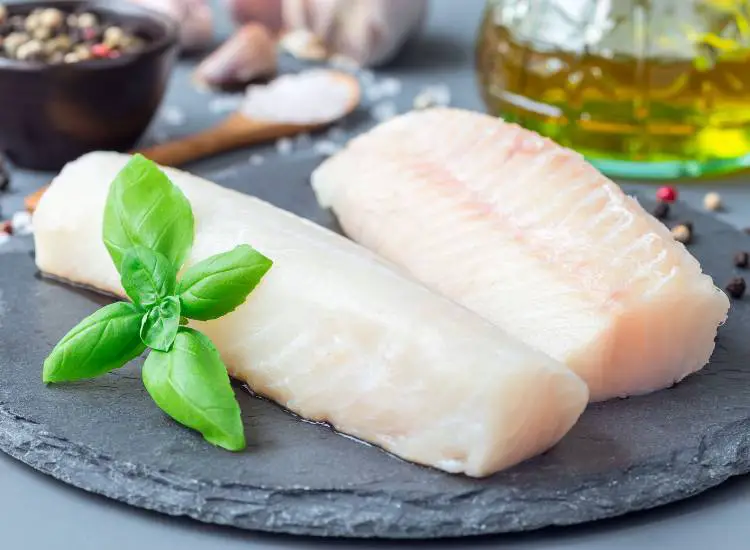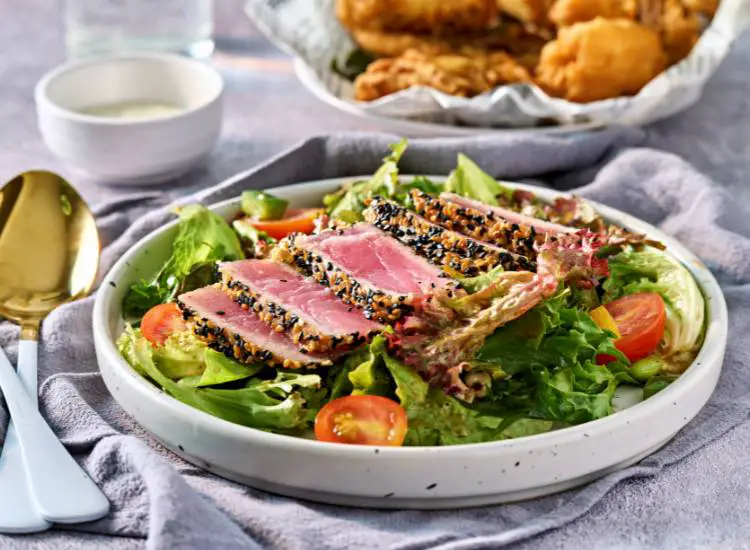Calories in Fish: How Many Are in Your Favorite Type?
Maybe you’ve heard about the long list of health benefits there are to eating fish. It’s packed with important nutrients such as protein and vitamin D.
But did you know that eating fish has also become more popular in recent years? The consumption of fish and shellfish in the United States steadily climbed from 2000 to 2018.
Just like meat and poultry, the calories in fish can vary when comparing different types. In the sections below, I’ve outlined 21 popular types of fish and their nutritional content.
What is a Serving Size of Fish?
A plate of salmon is certainly not the same as one sardine. So, how do you accurately measure a serving size of fish?
According to the Food and Drug Administration, a typical serving of fish is 3-4 ounces, measured before cooking.

That’s about the size and thickness of an adult’s palm. Comparing portion sizes with your hand can be a great way to measure food when you need to guess.
And while a food scale will always be more accurate, it’s unrealistic to bring this tool to a restaurant. Imagine the looks you would get!
Is Fish Healthy?
It’s no secret that eating fish on a regular basis can be good for you. So, how often should you consume different types of fish?
The FDA recommends eating 2-3 servings of cooked fish, or about 8-12 ounces each week. Some benefits of including fish in your diet are:
- High in nutrients
- May boost brain health
- Can lower risk of heart attacks
- Good source of vitamin D
- Can help improve sleep quality
- May help protect vision in old age
If you’re someone who doesn’t enjoy the taste of fish, consider trying the many different varieties listed below. They all have their own unique textures and flavors.
How Many Calories Are in Fish?
For this comparison, we’re looking at raw 3 ounce fish calories. This is a more accurate measurement, because the weight changes after cooking.
Plus, ingredients used in cooking can also vary the nutritional content of fish. Things like butter and oil will increase the calories, so the raw fish calories gives us a better baseline.

When you compare 3 ounce portions, the average fish calories per serving is around 98 calories. That’s roughly 33 calories per ounce of raw fish.
How Much Protein is in Fish?
Fish is a great source of protein. But some varieties contain more than others. The average 3 ounce portion of fish has around 16 grams of protein.
That’s not as much compared to steak and poultry, but remember that fish is relatively low in calories. This makes fish ideal for people trying to lose weight and still eat plenty of protein.
How Much Fat is in Fish?
Fish is also an excellent source of healthy fats. This superfood contains omega-3 fatty acids, which are essential nutrients for our heart and brain.
The average 3 ounce portion of fish has roughly 3 grams of fat. Mackerel and salmon contain higher amounts of fat, so keep that in mind when building your shopping list.
Calories & Nutrition for Every Type of Fish
Now let’s take a look at the calories and nutrition facts for some of the most popular varieties of fish.
And while there are other types you can eat, most of these can be found at restaurants, or your local grocery store.
Remember, the nutritional content below is for 3 ounce portions of uncooked fish. The amount of calories will change when you grill, pan fry, bake, or sauté fish, because cooking food causes a loss of water content.
Alaskan Pollock

| Alaskan Pollock (3 oz) | Nutrition |
|---|---|
| Calories | 65 |
| Fat | 1g |
| Carbs | 0g |
| Protein | 15g |
Location: Bering Sea, North Pacific Ocean
Anchovies

| Anchovies (3 oz) | Nutrition |
|---|---|
| Calories | 111 |
| Fat | 4g |
| Carbs | 0g |
| Protein | 17g |
Location: Atlantic Ocean, Indian Ocean, Pacific Ocean, Black Sea, and Mediterranean Sea
Atlantic Mackerel

| Atlantic Mackerel (3 oz) | Nutrition |
|---|---|
| Calories | 174 |
| Fat | 12g |
| Carbs | 0g |
| Protein | 16g |
Location: Baltic Sea, North Atlantic Ocean
Bass

| Bass (3 oz) | Nutrition |
|---|---|
| Calories | 82 |
| Fat | 2g |
| Carbs | 0g |
| Protein | 15g |
Location: Clear, vegetated lakes, ponds, swamps, and the backwaters of pools, creeks and rivers
Branzino (European Sea Bass)

| Branzino (3 oz) | Nutrition |
|---|---|
| Calories | 82 |
| Fat | 2g |
| Carbs | 0g |
| Protein | 16g |
Location: Mediterranean Sea and the Northeastern Atlantic Ocean
Carp

| Carp (3 oz) | Nutrition |
|---|---|
| Calories | 108 |
| Fat | 5g |
| Carbs | 0g |
| Protein | 15g |
Location: Eurasia and North America
Catfish

| Catfish (3 oz) | Nutrition |
|---|---|
| Calories | 81 |
| Fat | 2g |
| Carbs | 0g |
| Protein | 14g |
Location: North America, South America, Asia, and Africa
Cod

| Cod (3 oz) | Nutrition |
|---|---|
| Calories | 70 |
| Fat | 1g |
| Carbs | 0g |
| Protein | 15g |
Location: Northern Pacific Ocean, Gulf of Alaska, Aleutian Islands, and the Bering Sea
Flounder

| Flounder (3 oz) | Nutrition |
|---|---|
| Calories | 60 |
| Fat | 2g |
| Carbs | 0g |
| Protein | 11g |
Location: Atlantic coast of North America, northern Pacific Ocean, and the coasts of Europe
Haddock

| Haddock (3 oz) | Nutrition |
|---|---|
| Calories | 63 |
| Fat | 0g |
| Carbs | 0g |
| Protein | 14g |
Location: North Atlantic Ocean
Herring

| Herring (3 oz) | Nutrition |
|---|---|
| Calories | 134 |
| Fat | 8g |
| Carbs | 0g |
| Protein | 15g |
Location: North Pacific Ocean, North Atlantic Ocean, Baltic Sea, and off the west coast of South America
mahi-mahi (Dolphinfish)

| Mahi-mahi (3 oz) | Nutrition |
|---|---|
| Calories | 72 |
| Fat | 1g |
| Carbs | 0g |
| Protein | 16g |
Location: Atlantic Ocean, Gulf of Mexico, and the Caribbean
Pacific Halibut

| Pacific Halibut (3 oz) | Nutrition |
|---|---|
| Calories | 77 |
| Fat | 1g |
| Carbs | 0g |
| Protein | 16g |
Location: North Pacific Ocean
Pike

| Pike (3 oz) | Nutrition |
|---|---|
| Calories | 75 |
| Fat | 1g |
| Carbs | 0g |
| Protein | 16g |
Location: Arctic portions of North America, Europe, Asia, and Siberia
Rainbow Trout

| Rainbow Trout (3 oz) | Nutrition |
|---|---|
| Calories | 101 |
| Fat | 3g |
| Carbs | 0g |
| Protein | 17g |
Location: Pacific Ocean watershed off portions of North America and Asia
Red Snapper

| Red Snapper (3 oz) | Nutrition |
|---|---|
| Calories | 85 |
| Fat | 1g |
| Carbs | 0g |
| Protein | 17g |
Location: Gulf of Mexico and along the eastern coasts of North America, Central America, and northern South America
Salmon

| Salmon (3 oz) | Nutrition |
|---|---|
| Calories | 121 |
| Fat | 5g |
| Carbs | 0g |
| Protein | 17g |
Location: North America, Iceland, Greenland, Europe, and Russia
Sardines

| Sardines (3 oz) | Nutrition |
|---|---|
| Calories | 177 |
| Fat | 10g |
| Carbs | 0g |
| Protein | 21g |
Location: Pacific Ocean, Indian Ocean, western North and South America, Japan, Australia, and South Africa
Swordfish

| Swordfish (3 oz) | Nutrition |
|---|---|
| Calories | 122 |
| Fat | 6g |
| Carbs | 0g |
| Protein | 17g |
Location: Atlantic Ocean, Indian Ocean, and Pacific Ocean
Tilapia

| Tilapia (3 oz) | Nutrition |
|---|---|
| Calories | 96 |
| Fat | 2g |
| Carbs | 0g |
| Protein | 20g |
Location: Africa and the Middle East
Tuna

| Tuna (3 oz) | Nutrition |
|---|---|
| Calories | 93 |
| Fat | 1g |
| Carbs | 0g |
| Protein | 21g |
Location: Pacific Ocean
Frequently Asked Questions
Which fish is lowest in calories?
Alaskan Pollock, Flounder, and Haddock contain the fewest calories. On average these fish have around 63 calories for a 3 ounce portion.
Which fish is high in calories?
Mackerel, Sardines, Herring, Swordfish, and Salmon have the highest amount of calories. On average there are roughly 146 calories for a 3 ounce portion.
Which fish has the lowest fat?
Alaskan Pollock, Cod, Haddock, Mahi-mahi, Pacific Halibut, Pike, Red Snapper, and Tuna have the lowest amount of fat. On average these fish have less than 1 gram of fat for a 3 ounce portion.
